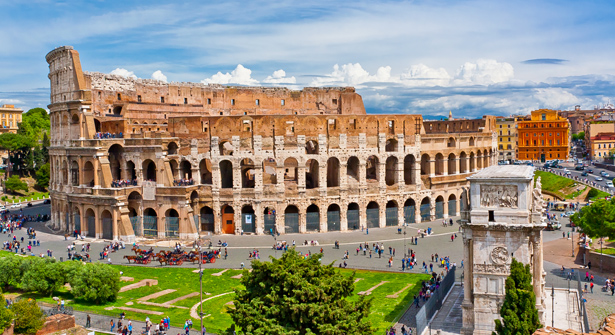
Italy Travels offers different options to visit the Colosseum and the Roman Forum including the booked time access
-
Book your visit to the Colosseum & Roman Forum
♦ Colosseum booked time guaranted
includes the Roman Forum & Palatine Hill, Multimedia experience of Romeprice from 8.00 euros book now -
-
Book your visit to the Colosseum Only Arena
♦ Colosseum access time guaranted
includes the Roman Forum & Palatine, Imperial Forums, Multimedia experience of Romeprice from 10.00 euros
-
-
Full Experience: Colosseum + Arena
♦ Colosseum access time guaranted + Arena
includes access to the Roman Forum & Palatine Hill, Multimedia experience of Romeprice from 12.00 euros book now -
Book your visit to Roman Forum & Palatine Museum
♦ Open daily reservation
includes access to the Roman Forums & Palatine Museum, Multimedia experience of Romeprice from 10.00 euros book now -
Domus Aurea Guided Tour & the Imperial Rome
♦ Booked access time to the Domus Aurea
includes guided tour to Domus Aurea & Colosseum area,3 hours tourprice from 19.00 euros book now
-
Colosseum Tour with Exclusive Guide
♦ Booked time Entrance - Colosseum & Roman Forum
duration about 3 hours - any language on your choice - professional Guideestimate the tour -
Colosseum + Underground Tour with Exclusive Guide
♦ Booked time Entrance - Colosseum & Roman Forum
duration about 3 hours - any language on your choice - professional Guideestimate the tour
-
Imperial Forums with Exclusive Guide
♦ Booked time Entrance
duration about 3 hours - any language on your choice - professional Guideestimate the tour
Visit the Colosseum in Rome, book your experience!
A visit in Rome really cannot exclude a visit to the Colosseum. First of all, the Colosseum is the symbol of Rome and Italian ancient history. The Colosseum is located in the centre of Rome. The monument stands at the end of a street, in Via dei Fori Imperiali. Due to the presence of the Colosseum and other Roman ruins, the street itself is an open-air museum. Roman antiquities follow your sight at your right, while walking towards the magnificent Colosseum.
After visiting the Colosseum, using the same voucher you have bought on line, you can also visit the Roman Forum and the the external archaelogical area of the Palatine. Therefore this reservation will give you the chance to visit three important monuments of Rome with just one single booking. The Colosseum is also known as Flavio Amphitheatre, as its construction was ordered by the Flavian dynasty. The reason why the amphitheatre was called "Coliseum" is not certain. Among the most plausible explanations the name "Coliseum" comes from a huge, colossal statue of Nerone that in ancient times was placed near the amphitheatre entrance.
The Coliseum has a long and compelling story, imprinted in every stone. The Colosseum is a monument that has had multiple functions over the centuries. Above all the Colosseum hosted gladiators' shows and
naval battles! Even more in the arena there were also shows with wild beasts. Therefore the story of this extraordinary monumnet is absolutely worth listening to.
The monument dimensions
The size of the Colosseum in its original plan boasted 52 meters high and 527 meters in perimeter. The amphitheater was well equipped with 76 entrances reserved for public access. On the arches to the right of the entrance you can still see the numbers above each entrance, in Roman numerals. In addition, there were for four entrances for logistics and services. This immense structure could accommodate a total of 50,000 spectators. 45,000 seated and 5,000 standing in the top area, which corresponds to the fifth level. In this section there were usually the slaves and the common people.
To protect the public from the sun and the rain there was a complex removable protective structure called the “Velarium”. This was composed of triangles of transparent fabric and waterproof canvas. The triangles were connected by metal rings and the removable structure was controlled by pulleys, hoists and ropes which were operated by 300 sailors. Outside the Colosseum, 100 meters to the left of the entrance, you can still see the five cleats that secured the anchor ropes that held up the giant mobile structure.
The Shows in the Colosseum
The shows were organised during the summer for 18 hours a day. In contrast, during the winter only for 15 hours a day. Shows were planned two or three times a year in cycles of a week or more, but not every day. First of all beceuse the overall maintenance of the complex was very expensive.
In the mornings the fights took place with the wild beasts, lions, tigers, panthers, elephants, bulls, mastiffs dogs, bears, wild boars and gladiators. Weapons used included the trident, net, iron plated gloves and the Roman gladius sword which was about 70cm in length.
In the afternoons the audience watched the gladiators fight. The battles did not always end in the death of one of them. Actually the gladiators were considered public figures very dear to the people. Therefore they did not welcome death.









